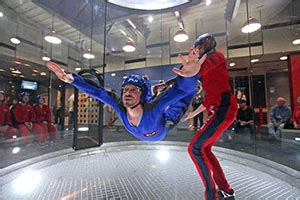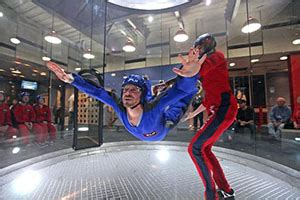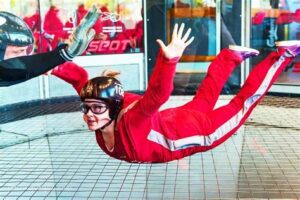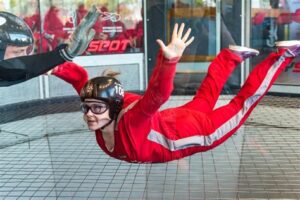Table of Contents
Indoor skydiving injuries can occur during this thrilling and adrenaline-pumping activity. This article explores the potential risks and common injuries associated with indoor skydiving, providing valuable insights for enthusiasts and beginners alike. Understand the precautions to take and how to enjoy this exhilarating sport while minimizing the chances of injury.
Indoor skydiving, also known as bodyflight or vertical wind tunnel flying, has gained immense popularity in recent years as a thrilling recreational activity. However, amidst the exhilaration and adrenaline rush, there is an inherent risk of injuries that cannot be overlooked. While indoor skydiving may seem like a safe alternative to its outdoor counterpart, it is crucial to understand the potential risks involved. In this article, we will delve into the various injuries that can occur during indoor skydiving, offering valuable insights for enthusiasts and beginners alike. So, fasten your seatbelts and get ready to explore the world of indoor skydiving injuries.
Introduction
Indoor skydiving has become a popular recreational activity for thrill-seekers and aviation enthusiasts alike. This simulated freefall experience offers individuals the opportunity to feel the rush of skydiving without the need for an airplane or parachute. However, like any extreme sport, indoor skydiving carries certain risks that participants should be aware of. In this article, we will explore some of the common injuries associated with indoor skydiving and discuss ways to mitigate these risks.
The Mechanics of Indoor Skydiving
Before delving into the potential injuries, it is important to understand the mechanics of indoor skydiving. Participants enter a vertical wind tunnel, where powerful fans generate a strong upward airflow. This creates a cushion of air that allows individuals to float and simulate the sensation of freefall. While the controlled environment minimizes some risks, there are still inherent dangers involved.
1. Bruises and Scrapes
During indoor skydiving sessions, participants may experience collisions with the tunnel walls or other flyers. These collisions can result in bruises and scrapes, especially if proper safety precautions are not followed. Wearing appropriate protective gear, such as jumpsuits and helmets, can significantly reduce the risk of these minor injuries.
2. Neck and Back Strains
The strong airflow in the wind tunnel exerts pressure on the body, particularly the neck and back. Maintaining the correct body position is crucial to prevent strains or muscle sprains. Participants should receive proper instruction on body alignment and avoid excessive twisting or sudden movements during their flight. Stretching exercises before and after the session can also help alleviate tension in these areas.
3. Eye Irritation
The high-speed airflow inside the wind tunnel can cause dryness and irritation to the eyes. Goggles or protective eyewear are recommended to shield the eyes from excessive airflow and prevent debris from entering. Proper hydration before the session can also help maintain eye moisture.
4. Ear Barotrauma
Changes in air pressure during the freefall simulation can lead to ear barotrauma, causing discomfort or even injury. Equalizing the pressure in the ears by swallowing, yawning, or using the Valsalva maneuver can help prevent this condition. It is important to listen to instructions provided by instructors on proper techniques for equalizing ear pressure.
5. Sprained Ankles
When landing after a simulated freefall, participants need to maintain a stable and controlled posture to avoid spraining their ankles. Failing to land properly can result in twisted or sprained ankles. Understanding the correct landing technique and following the instructor’s guidance are crucial to prevent these types of injuries. Wearing supportive footwear can also provide additional stability.
6. Shoulder Dislocation
During indoor skydiving, participants often utilize their arms to control their body position. This can put strain on the shoulders, potentially leading to dislocations if excessive force is applied. It is essential to follow proper technique and gradually build strength to avoid putting undue stress on the joints. Warm-up exercises and stretching can help prepare the muscles and reduce the risk of shoulder dislocation.
7. Impact Injuries
In rare cases, severe impact injuries can occur if participants lose control or collide with other flyers at high speeds. These incidents can result in fractures, concussions, or more serious injuries. Adhering to safety protocols, such as maintaining a safe distance from other flyers and following instructor guidance, is crucial to prevent such accidents.
8. Psychological Effects
Indoor skydiving, despite being a controlled environment, can still trigger psychological effects such as anxiety or panic attacks in some individuals. The sensation of freefalling can be overwhelming for those who are not accustomed to it. Participants should be aware of their own comfort levels and communicate any concerns to the instructors. Proper guidance and support can help alleviate these psychological effects.
Conclusion
While indoor skydiving offers a thrilling experience, it is essential to recognize and address the potential risks associated with this activity. By following proper safety measures, receiving adequate instruction, and being mindful of one’s physical limitations, participants can minimize the chance of injuries and fully enjoy their simulated freefall adventure.
Preparing for Indoor Skydiving
Before engaging in an indoor skydiving session, it is crucial to ensure that you have the right gear. The facility will typically provide the necessary safety gear, including a jumpsuit, helmet, goggles, and earplugs. It is essential to wear these items at all times during the activity to minimize potential injuries.
Another important aspect of preparation is understanding the safety briefing provided by the instructors. Pay close attention to the hand signals, body positions, and emergency procedures explained during the briefing. This knowledge will help ensure a safer and more enjoyable session.
Maintaining physical fitness is also crucial for indoor skydiving. This activity requires some physical exertion, so it is important to be in good health. If you have any pre-existing medical conditions or injuries that may impact your ability to participate safely, inform the instructors beforehand.
Common Minor Injuries
2.1 Bruises and Scrapes
Due to the wind forces generated during indoor skydiving, it is not uncommon to experience minor bruises or scrapes. These injuries typically occur when participants come into contact with the walls or the netting structure within the wind tunnel. While these injuries are generally minor, it is still important to be aware of them and take precautions to avoid unnecessary contact with the surroundings.
2.2 Muscle Soreness
Engaging in repeated body movements and maintaining the required body positions during indoor skydiving can result in muscle soreness. This soreness is usually temporary and can be alleviated by stretching and warm-up exercises before and after the session. It is important to listen to your body and not overexert yourself to prevent excessive muscle soreness.
2.3 Minor Bruises from Harness
Wearing a harness during indoor skydiving can sometimes lead to minor bruising around the areas where the straps make contact with the body. To prevent or minimize such bruises, it is important to ensure that the harness is properly fitted and adjusted. If you experience discomfort from the harness, notify the instructors so they can make necessary adjustments.
Potential Risks and Precautions
3.1 Neck and Back Injuries
Sudden or improper body movements during indoor skydiving can strain the neck and back muscles, leading to potential injuries. It is crucial to follow the instructions provided by the instructors and maintain proper body alignment and posture throughout the entire session. This will help minimize the risk of straining these muscles and reduce the likelihood of injuries.
3.2 Ear Discomfort
The rapid changes in air pressure experienced during indoor skydiving may cause ear discomfort or temporary hearing loss. To prevent this, make sure to wear the provided earplugs. Additionally, techniques such as swallowing or yawning can help equalize the pressure in your ears. By taking these precautions, you can minimize the chances of experiencing discomfort or hearing-related issues.
3.3 Allergic Reactions
If you have known allergies to dust or any other airborne particles, indoor skydiving facilities may not be suitable for you. The wind generated in the tunnel may stir up dust, potentially triggering allergic reactions. Before participating in indoor skydiving, it is advisable to consult with your doctor to determine if it is safe for you based on your specific allergies.
It is important to note that indoor skydiving injuries can vary in severity based on individual experiences, fitness levels, and adherence to safety guidelines. To minimize the risk of injuries during your indoor skydiving session, always consult with professional instructors and follow their instructions. By doing so, you can have a safer and more enjoyable experience.
Point of View: Indoor Skydiving Injuries
In this instructional guide, we will provide you with an overview of indoor skydiving injuries. It is essential to understand the potential risks associated with this exhilarating activity to ensure your safety and minimize the chances of accidents. Please carefully read and follow these instructions to have a safe indoor skydiving experience.
-
Wear appropriate safety gear:
Before engaging in indoor skydiving, make sure to wear the proper safety gear provided by the facility. This typically includes a jumpsuit, helmet, goggles, and earplugs. Always check that the gear fits correctly and does not restrict your movement.
-
Listen to the instructor:
Pay close attention to the instructions given by the instructor during the pre-flight briefing. They will provide valuable information about body positioning, hand signals, and safety precautions. Follow their guidance carefully throughout the entire process.
-
Maintain a proper body position:
When inside the wind tunnel, maintain a stable body position to prevent injuries. Keep your chin up, arms slightly bent, and legs slightly apart. Avoid excessive movements or sudden jerks that can lead to strain or discomfort.
-
Know your limits:
Understand your physical limitations and do not attempt any maneuvers that are beyond your skill level. Pushing yourself too hard can increase the risk of injuries. Gradually progress as you gain confidence and experience in indoor skydiving.
-
Stay alert and aware:
While enjoying the thrill of indoor skydiving, always be aware of your surroundings and other participants in the wind tunnel. Collisions can occur if proper attention is not maintained. Be mindful of others and communicate using hand signals as instructed.
-
Report any discomfort or pain:
If you experience any discomfort, pain, or unusual sensations during your indoor skydiving session, immediately inform the instructor. They will assess the situation and provide appropriate guidance. Ignoring such symptoms may aggravate potential injuries.
-
Follow landing instructions:
When it is time to land, listen carefully to the instructor’s landing instructions. Maintain a relaxed posture, keep your legs slightly bent, and follow their guidance to ensure a safe landing. Do not attempt any sudden movements or maneuvers during this phase.
-
Refrain from alcohol or drugs:
Avoid consuming alcohol or drugs before participating in indoor skydiving. These substances impair judgment, coordination, and reaction time, significantly increasing the risk of accidents and injuries.
-
Know your health condition:
If you have any existing medical conditions, such as heart problems, back issues, or are pregnant, consult with your healthcare provider before engaging in indoor skydiving. They can provide guidance on whether it is safe for you to participate.
-
Be responsible for personal safety:
Ultimately, you are responsible for your own safety during indoor skydiving. Adhere to all safety guidelines, take necessary precautions, and exercise caution at all times. By doing so, you can minimize the risk of injuries and fully enjoy this thrilling activity.
Remember, indoor skydiving can be an incredible experience, but it is crucial to prioritize safety. By following these instructions and guidelines, you can ensure a safe and enjoyable indoor skydiving adventure.
Thank you for taking the time to visit our blog and learn more about the topic of indoor skydiving injuries. We hope that you have found this information valuable and informative. As you may already know, indoor skydiving has become a popular recreational activity in recent years, offering the thrill and excitement of skydiving in a controlled indoor environment. However, like any high-intensity sport or activity, there are inherent risks involved, and it is important to be aware of these potential dangers before participating.
First and foremost, it is crucial to understand that indoor skydiving, although safer than traditional outdoor skydiving, still carries certain risks. While the controlled environment of an indoor skydiving facility significantly reduces the chances of experiencing severe injuries, accidents can still occur. It is essential to follow all safety instructions provided by the facility staff and ensure that you are in good physical health before attempting indoor skydiving. By doing so, you can minimize the likelihood of sustaining any injuries and have a safer and more enjoyable experience.
One common concern among individuals considering indoor skydiving is the risk of concussions. Although rare, head injuries can occur if proper safety precautions are not followed. The most effective way to prevent head injuries is to wear a well-fitted helmet during your indoor skydiving session. This will provide an extra layer of protection and absorb any impact that may occur. Additionally, be sure to listen carefully to the instructor’s guidance on body positioning and movement to avoid colliding with the walls or other participants, as this can also lead to head injuries.
In conclusion, while indoor skydiving is an exhilarating and thrilling activity, it is important to approach it with caution and prioritize your safety. By following the instructions provided by the facility staff, wearing appropriate safety gear such as helmets, and being mindful of your surroundings, you can significantly reduce the risk of sustaining injuries. Remember, the goal is to have a fun and enjoyable experience while ensuring your well-being. We hope that this article has provided you with valuable insights into indoor skydiving injuries and how to avoid them. Stay safe, and happy indoor skydiving!
Thank you once again for visiting our blog, and we hope to see you back soon for more informative articles on various topics. If you have any further questions or would like to share your own experiences related to indoor skydiving injuries, please feel free to leave a comment below. Your feedback and engagement are highly appreciated!
Video Indoor Skydiving Injuries
People also ask about Indoor Skydiving Injuries:
-
What are the common injuries associated with indoor skydiving?
-
Are there any risks of fractures or broken bones while indoor skydiving?
-
Can I get injured if I have pre-existing medical conditions?
-
What safety precautions are in place to prevent injuries?
-
Is indoor skydiving safer than outdoor skydiving?
During indoor skydiving, the most common injuries include minor bruises, muscle strains, and sprains. These injuries usually occur when participants lose balance or collide with the walls of the wind tunnel. However, serious injuries are rare due to the controlled environment and safety measures in place.
The risk of fractures or broken bones during indoor skydiving is extremely low. The airflow in the wind tunnel is carefully regulated, minimizing the chances of high-impact collisions. Additionally, participants are provided with safety gear such as helmets and padded suits to further reduce the risk of bone-related injuries.
It is essential to consult with your physician before engaging in any physical activity, including indoor skydiving, especially if you have pre-existing medical conditions. People with certain health issues, such as heart problems, back or neck injuries, or pregnancy, may be advised to avoid indoor skydiving to prevent exacerbating their condition.
Indoor skydiving facilities prioritize safety and have various precautions in place. They provide thorough instructions and training sessions to ensure participants understand proper body positioning and movements. Instructors closely supervise each session, offering guidance and assistance if needed. Additionally, participants are required to wear safety equipment, including helmets, goggles, and padded suits, to minimize the risk of injuries.
Indoor skydiving is generally considered safer than outdoor skydiving due to the controlled environment and reduced risk of high-impact collisions. The wind tunnel provides a stable and predictable airflow, minimizing the chances of accidents. However, it is important to follow all safety guidelines and instructions provided by the facility to ensure a safe and enjoyable experience.






